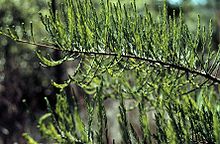User:Amgehron19/Taxodium ascendens
| This is the sandbox page where you will draft your initial Wikipedia contribution.
If you're starting a new article, you can develop it here until it's ready to go live. If you're working on improvements to an existing article, copy only one section at a time of the article to this sandbox to work on, and be sure to use an edit summary linking to the article you copied from. Do not copy over the entire article. You can find additional instructions here. Remember to save your work regularly using the "Publish page" button. (It just means 'save'; it will still be in the sandbox.) You can add bold formatting to your additions to differentiate them from existing content. |
Taxodium ascendens
[edit]Introduction
[edit]Taxodium ascendens or the Pond Cypress is a perennial gymnosperm that is found in the southeastern United States. The pond cypress is similar too and often confused with Taxodium distichum or the Bald Cypress.
| Amgehron19/Taxodium ascendens | |
|---|---|

| |
| Foliage | |
| Scientific classification | |
| Kingdom: | Plantae |
| Clade: | Tracheophytes |
| Clade: | Gymnospermae |
| Division: | Pinophyta |
| Class: | Pinopsida |
| Order: | Cupressales |
| Family: | Cupressaceae |
| Genus: | Taxodium |
| Species: | T. ascendens
|
| Binomial name | |
| Taxodium ascendens | |
Description
[edit]Cypresses are known for their prominent "knees" and buttressed trunks that define the species however Taxodium ascendens is less likely to have "knees" than Taxodium distichum.[2] Taxodium ascendens is classified as a perennial gymnosperm that is native to the southeastern United States.[3] Pond cypress are typically between 50 - 85 ft tall and 15-30 ft wide.[4] The pond cypress leaves are more needle-shaped (like the shaft of an awl or a screwdriver), in a spiral arrangement that stays close to the stem.[5] The leaves are deciduous, simple, alternate, awl-like needles. Its cones are round, ovulate, between 1/2 - 1 1/4 inches long.[6] Due to the dry nature of the habitat for the pond cypress, it has developed thicker, fire resistant bark. Their seeds require fire before they can sprout.[2]
Taxonomy
[edit]Taxodium ascendens is a gymnosperm that falls into the Cupressaceae family since it produces cones.[7] The pond cypress is also known by other synonyms "Taxodium distichum var. imbricatum (Nutt.) Croom"[8] and "Taxodium distichum var. ascendens (Brongn.) Mast."[9]
Distribution and Habitat
[edit]Taxodium ascendens was discovered and identified by its original authority Adolphe-Théodore Brongniart in 1833.[10]
Taxodium ascendens is most frequently found in the South Eastern United States ranging from Virginia to Louisiana.[11] The pond cypress' preferred habitat is along the banks of ponds and lakes where the water is stagnant.[12] This tree is native to southern swamps, bayous and rivers, and is known to tolerate extended periods of intense flooding.[13] Pond cypress are most frequently found in isolated depressions feed by nutrient poor, shallow ground water.[2] Taxodium ascendens grows easily in average, medium to wet, moisture-retentive but reasonably well-drained soils in full sun. It prefers moist, acidic, sandy soils, but tolerates a wide range of soil conditions ranging from average moisture soils to wet soils in standing water.[13]
Uses
[edit]Taxodium ascendens is typically used for ornamental purposes or decoration in more urban environments unlike the bald cypress which can be used in heavy duty construction.[4][14] Pond cypress are also used in wetland restoration and enhancement.[4]
Ecological Benefits
[edit]Like many other large semi aquatic plants, Taxodium ascendens provides shelter to young aquatic animals, prevents predatory fish from getting established and this allows frogs and other amphibians to thrive. Specifically the endangered flatwood's salamander will only lay their eggs in dry ponds populated with Taxodium ascendens.[2]
Etymology
[edit]The variety name (imbricarium) means “overlapping” in reference to the manner in which the leaves lie on the twigs.[12] The term “ascendens” hints at the leaves that point or grow upward in an arching or curving fashion.[12]
Fire Ecology
[edit]Taxodium ascendens is susceptible to fires during the drier arid seasons where ponds lose the majority of their water but these trees have developed a thicker bark to better survive these instances. The pond cypress also utilizes fires in order to let their seeds sprout.[3]
Conservation Status
[edit]The pond cypress is considered "apparently secure" (S4) in North Carolina, "critically imperiled" (S1) in Virginia, and "exotic" in Delaware.[15]
References
[edit]- ^ "NatureServe Explorer 2.0 - Taxodium ascendens, Pond Cypress". explorer.natureserve.org. Retrieved 6 May 2020.
- ^ a b c d Communications, IFAS. "Pond Cypress - Institute of Food and Agricultural Sciences - University of Florida, Institute of Food and Agricultural Sciences - UF/IFAS". programs.ifas.ufl.edu. Retrieved 2023-11-15.
- ^ a b "USDA Plants Database". plants.usda.gov. Retrieved 2023-11-15.
- ^ a b c "Florida Native Plant Society (FNPS)". www.fnps.org. Retrieved 2023-11-15.
- ^ "Year of the Tree: Bald Cypress or Pond Cypress? | NC State Parks". www.ncparks.gov. 2022-09-01. Retrieved 2023-11-15.
- ^ "ENH-777/ST619: Taxodium ascendens: Pondcypress". edis.ifas.ufl.edu. Retrieved 2023-11-15.
- ^ "NatureServe Explorer 2.0". explorer.natureserve.org. Retrieved 2023-11-15.
- ^ "Taxodium distichum var. imbricarium x Taxodium muc". CABI Compendium. 2022-01-07. Retrieved 2023-11-15.
- ^ "Taxodium distichum var. ascendens | International Plant Names Index". www.ipni.org. Retrieved 2023-11-15.
- ^ "Taxodium ascendens Brongn. | Plants of the World Online | Kew Science". Plants of the World Online. Retrieved 2023-12-05.
- ^ "Taxodium ascendens, T. distichum". www.fs.usda.gov. Retrieved 2023-11-15.
- ^ a b c Milligan, Lara (2018-03-30). "The Great Cypress Debate". UF/IFAS Extension Pinellas County. Retrieved 2023-11-15.
- ^ a b "Taxodium distichum var. imbricarium (Pond Cypress) | North Carolina Extension Gardener Plant Toolbox". plants.ces.ncsu.edu. Retrieved 2023-11-15.
- ^ "Bald Cypress (Taxodium distichum)". tpwd.texas.gov. Retrieved 2023-11-15.
- ^ "NatureServe Explorer 2.0". explorer.natureserve.org. Retrieved 2023-12-05.

